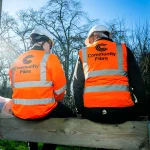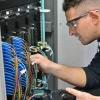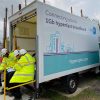New UK Gov Reiterates Call for Limits on Building Broadband Poles UPDATE

The new Labour-led UK Government has somewhat echoed the previous administration today by calling on broadband operators to “end the deployment of unnecessary telegraph poles” when rolling out new gigabit-capable networks. But they have “at this stage” rejected the idea of removing Permitted Development (PD) rights for poles.
As we’ve said before, network operators typically like poles because they’re quick and cost-effective to build, can be deployed in areas where there may be no space or access to safely put new underground cables, are less disruptive (avoiding the noise, access restrictions and damage to pavements of street works) and can be built under PD rights with only minimal prior notice.
Suffice to say that poles, which have long been a common sight across much of the UK (well over 4 million exist), form a key part of how broadband operators are choosing to deploy new full fibre (FTTP) networks. The previous government, driven by its targets for expanding gigabit-capable broadband infrastructure, even facilitated this by cutting red tape to help make such work as easy as possible.
Advertisement
On the other hand, over the last 2-3 years, there’s been a notable rise in complaints about new poles, particularly from places like East Yorkshire and Greater Manchester. Such gripes typically highlight their negative visual appearance, as well as concerns about exposure to damage from major storms, the lack of effective prior consultation, the duplication of existing infrastructure or engineers that fail to follow safety rules while building etc.
The previous government responded to this during March 2024 (here) by issuing somewhat of a soft warning to network operators, which called on them to “limit [the] installation of telegraph poles” and to avoid “inappropriately or unnecessarily throwing up new infrastructure.”
In addition, they also pledged to “revise” the existing Code of Practice (as linked above) to “make sure that communities feel engaged in the deployment of new broadband infrastructure, whilst still allowing operators to continue deploying their networks” (i.e. more community meetings and better pre-build notifications could be the result, adding extra costs and time to network builds but not stopping them).
Change of Approach or More of the Same
The recent change of UK government has, until today, left a bit of a question mark over how this issue would be tackled. On the one hand, the new government has talked a big game around boosting investment by softening planning rules and making a “renewed push to fulfil the ambition of full gigabit [broadband] and national 5G coverage by 2030.” On the other hand, some of its MPs are vocal opponents of poles (example).
Advertisement
The new Telecoms Minister, Sir Chris Bryant, has today sought to end that uncertainty by calling on the industry to “share existing infrastructure when installing broadband cables as the default approach; and where new infrastructure is needed, to install underground wherever possible before deploying new telegraph poles.”
Bryant has also written an open letter to the industry (see bottom of article), which supports the previous plan to revise the Code of Practice so that companies “pay greater attention to the communities’ concerns.”
Chris Bryant, Telecoms Minister, said:
“Our dedication to rolling out fast and reliable broadband across the country is unwavering. But this must happen in a way that is mindful of local communities, many of whom have expressed dismay when their road is dug up yet again or yet another telegraph pole appears in their street.
This is why I’m calling on telecoms companies to prioritise the sharing of infrastructure and take into account the views of residents and businesses in rural areas.
By doing so, we can bring the advantages of high-speed internet to all corners of the nation more rapidly and responsibly, while minimising disruptive ground digging and ending the installation of unnecessary telegraph poles – ensuring communities’ concerns are not overlooked.”
An Openreach spokesperson said:
“The UK is undergoing a digital transformation, to world class full fibre broadband. To help companies build out their networks, we offer access to our national network of poles and underground ducts. To date over 100 companies are making use of our ducts and poles, and it’s enabled them to connect nearly 900,000 of their customers.
We welcome greater collaboration within the industry and believe all network builders should offer access on comparable terms to us, thereby reducing the need for new poles and duct in certain areas. However, there will be a need for new infrastructure to ensure some premises aren’t left behind. We’re looking forward to working with Government to ensure the digital transformation of the UK continues at pace, which will include improved infrastructure sharing.”
Bryant’s letter adds that he “will not shy away from changing the law, should companies fail to listen to communities” (i.e. a reference to the possibility of hardening or removing PD rights on poles). The minister next plans to meet representatives from Openreach (BT), Virgin Media (O2) and smaller networks on 12th September 2024 to discuss how they can better “put residents’ concerns at the forefront of their plans” via a revised Code of Practice.
However, most network operators would probably say they already do everything possible to share existing poles and ducts (Openreach’s network is widely re-used by rivals), since that’s a lot more cost-efficient than building new stuff. But this isn’t available to every location and sometimes local restrictions, as well as any limitations (commercial or practical) imposed by existing operators, mean that it’s not always possible (i.e. sometimes no viable underground alternatives exist to poles).
Advertisement
The existing Access to Infrastructure (ATI) Regulations 2016, which applies to all operators, already includes provisions on the exchange of information about existing infrastructure, and the right to access that infrastructure on fair and reasonable commercial terms etc. But this doesn’t matter much if a commercially viable deal cannot be reached. The recent efforts between Connexin and KCOM in Hull suggest that, with enough of a push, solutions can sometimes still be found (here).
The previous government attempted to correct the ATI regulations, but some smaller and more vulnerable alternative networks (altnets) said they were concerned about the risk of “unintended consequences” if changes to those rules ended up undermining their investment case for new networks (here). Such operators also expressed “limited interest in using non-Openreach or non-telecoms infrastructure” (i.e. it’s hard to beat Openreach’s regulated product).
In the end, the previous government opted to merely clarify the existing ATI rules and later pushed to update the Code of Practice, which seems to be the same approach as now being adopted by the new government. In fairness, given the extreme economic pressures facing network builders right now, there’s probably not much the government can do without damaging their own targets.
Copy of Chris Bryant’s Letter to Network Operators
Dear all,
I am writing to you following my appointment as Minister of State with responsibility for telecoms infrastructure.
As you will know, this Government wants to drive economic growth across the UK, and we see delivering fast and reliable broadband as crucial to this mission. We want to give communities across all four nations opportunities to work, learn and play in ways that wouldn’t previously be possible without it.
However, I am acutely aware of public concerns surrounding the deployment of telegraph poles. Many people are calling for the Government to remove permitted development rights for poles. I do not, at this stage, believe that this is the right move. I want to ensure that my Department does everything it can to support fast-paced rollout of digital infrastructure across the UK to meet the Government’s objectives.
However, at the same time, we must look to address the concerns that people across this country have expressed and recognise that unnecessary pole deployment is immensely frustrating for them. I am grateful for the industry coming together to reform the Cabinet Siting and Pole Siting Code of Practice, and the work you have already undertaken to drive this work forward.
This work should of course be done in cooperation with local planning authorities, highway authorities and other interested parties to make sure that a diverse range of voices are considered and so that the guidelines fall under regulation 17 of the Electronic Communications Code (Conditions and Restrictions) Regulations 2003. My officials would be happy to facilitate connections, in order for the Working Group to reach planning or highway authorities in order to consult them on changes to the Code of Practice.
While the contents of this revised Code of Practice are for your Working Group to design; it is my hope that a revised Code of Practice can set out examples of considerations that should be taken into account before new poles are deployed; and that it can be brought into effect this autumn to ensure that community voices can be taken into account.
A revised Code of Practice is vital to ensuring continued smooth broadband rollout. I would therefore like to invite you to a roundtable on 12 September to discuss this project with me. At that roundtable I would also appreciate your commitment that you will do everything possible to share infrastructure and deploy poles in a considerate way.
Should the revised Code of Practice fail to address those public concerns and lead to far greater infrastructure sharing and fewer unnecessary pole deployments; I will not hesitate to consider changing existing regulations or wider legislative options to ensure that communities’ concerns are taken into account when deploying infrastructure.
Sir Chris Bryant MP
Minister of State for Data Protection and Telecoms
UPDATE 8:33am
Added a comment from Openreach above.
Mark is a professional technology writer, IT consultant and computer engineer from Dorset (England), he also founded ISPreview in 1999 and enjoys analysing the latest telecoms and broadband developments. Find me on X (Twitter), Mastodon, Facebook, BlueSky, Threads.net and Linkedin.
« ISP Wessex Internet Puts FTTP Live in 2 Hampshire UK Villages
The Top 71 Slowest and Fastest UK Cities for Broadband Speed »























































Hull pole massive incoming in t-minus…
Openreach mouth piece gasped “The UK is undergoing a digital transformation, to world class full fibre broadband.”
OK, what’s WOLRD CLASS about GPON and asymmetric broadband? Symmetric isn’t until April 2025 and then in new areas only and likely at expensive premium to deter many.
OTHER Altnets, then World Class might apply with 10gbps, symmetric, XGS-PON bit NOT Openreach deployment.
The company in Hull is MS3? I remember when I interviewed with then they told me they only use new poles when they can’t use existing poles.. maybe it was a lie? Or maybe it’s the likes of openreach not allowing them to share there infrastructure (though I know BRSK use openreach infrastructure)
@J
The problem with Hull is that it’s covered by KCOM rather than Openreach. They are supposed to allow PIA access like Openreach but they apparently making it as difficult as they possibly can and Ofcom are not jumping on them like they would Openreach.
As we well know code operators do not put enough efforts in to share infrastructure that is why parts of hull and the East Riding of Yorkshire have been flooded with telegraph poles
I would kill for my area to be blighted by broadband poles
Increasing my speed from 3mbps down 400kbps up
I’m surprised openreach haven’t classed you as priority. I’m on 29 mbps down in theory could get a higher speed but the cabinet was full and they would rather focus on fttp. I asked them why I couldn’t get FTTP yet as brsk had rolled out in the area and my neighbours the street behind me could get it but apparently I’m not in scope till end of next year.. I’m not entirely sure how they’re planning their builds to be honest
I’m surprised openreach haven’t classed you as priority. I’m on 29 mbps down in theory could get a higher speed but the cabinet was full and they would rather focus on fttp. I asked them why I couldn’t get FTTP yet as brsk had rolled out in the area and my neighbours the street behind me could get it but apparently I’m not in scope till end of next year.. I’m not entirely sure how they’re planning their builds to be honest
Starlink. Buy Starlink.
In an ideal world asking nicely would work, it’s not an ideal world though is it.
They should speak to 6G Internet or opus as they’re reliant on poles due to how they operate essentially it’s over the air FTTP
“over the air FTTP”?!
How to contradict yourself in just four words.
They certainly should. IX Wireless (Opus broadband) are putting up loads of poles across the North West with no community engagement. This is despite the fact that there is underground fibre already, just doesn’t make sense.
Perhaps communities should be given a statutory right to compel networks to install their equipment underground and compensate them for the additional expense. That way everyone wins — communities can avoid “ugly” poles and infrastructure providers aren’t left to foot the bill for the preferences of a small but vocal group of people.
Whatever the case, it is imperative that people living in areas served via overhead lines do not subsidise (through their bills) people who insist on having their installation fed underground.
Most of the world is fed overhead and the amount of negativity from nimbism in this country is ridiculous.
Underground ducts made from ceramic material laid nearly 100 years ago which is not serviceable anymore is not viable to be replaced unless residents want to pay for it themselves.
I worked for Zen as a fault manager (now in management), and whenever there was a storm our fault management team was inundated with faults caused by downed fibre cables, snapped poles, and other aboveground infrastructure issues and more often than not, repairs would be delayed due to A55 rules which take time to get approval for the work to start. It’s very rare we had issues with underground fibres.
Going overground with poles is just a cheap and dirty option in my opinion.
“Going overground with poles is just a cheap and dirty option in my opinion.”
You forgot to add quick, which is probably the most important consideration during the this massive build period
Funny how this same phenomena never seems to happen to phone or power lines to any great extent.
One could similarly argue that my overhead cable has never fallen victim to flooding.
A55 rules? (a v. quick Google didn’t help)
A55 = openreach more works needed goes to the planners.
So eg
Pole downed on Monday A55 raised Tuesdays then pole replacement within the week apparently.
A55 also applys when needing to dig up underground infrastructure, usually takes alot longer
Two things in my view. No poles where they don’t already exist, and second requirements on speed of fix for poles and cables damaged in a storm. With massive fines for anything not fixed in say 5 days. You would suddenly find poles going out of favour. It might be cheap and quick to do poles but we also need a reliable and robust telecommunications infrastructure.
The last Labour government did SFA about improving the internet/IP connection in the UK. It could and should have reversed the decree issued by the previous government on allow BT to rollout FTTP to every premis in the UK. This government could direct some (or all) the cash given to the ‘Cherry Picking’ companies to BT/OR to actually speed up their deployment of FTTP.
With over a 100 AltNets doing the work – in many cases duplicating in high profit areas in the end alll the general public looses!
Seems like there should be a common standard to which poles are built and connected (probably similar to OpenReach standards), a period of time of exclusively for the builder of the pole – maybe six/nine months – and then for the infrastructure to be made available to other operators at similar commercial rates as OpenReach by the builder OR the poles and ducts are sold to OpenReach to operate and maintain at a bit of a discount compared to the cost for OpenReach to have built them themselves.
That would make sense if the poles were being put up where there was no existing infrastructure, but IX Wireless (OPUS Broadband) are putting up poles in the North West where Openreach and other providers already have infrastructure underground so why would others want to use their poles and “over the air FTTP” to provide WiFi to homes?